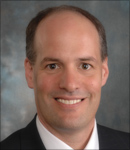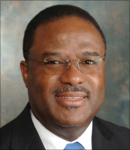AEP Texas comprises two primary operating companies. AEP Texas North Company delivers electricity on behalf of Retail Electric Providers (REPs) in west Texas, and AEP Texas Central Company delivers electricity on behalf of REPs in south Texas. Under deregulated Texas market guidelines, AEP Texas builds new power lines, reads meters for the REPs, restores service following outages and connects or disconnects service as requested by REPs. Although AEP Texas is but one of 7 operating companies under its corporate parent – American Electric Power – our interview is focused primarily on the strides being made under the gridSMART initiative currently being rolled out by AEP Texas. – Ed.

A. Wade Smith
President & Chief Operating Officer

Joel S. Murphy, Director
Customer Services & Marketing
EET&D : Let’s begin with a little bit of background on American Electric Power – your parent company – and then we’ll move on to AEP Texas itself.
Smith : AEP Texas is part of the American Electric Power system, one of the largest electric utilities in the United States, delivering electricity to more than 5 million consumers in 11 states. AEP ranks among the nation’s largest generators of electricity, owning nearly 38,000 megawatts of generating capacity in the U.S. AEP also owns the nation’s largest electricity transmission system, a nearly 39,000-mile network that includes more 765 kilovolt extra-high voltage transmission lines than all other U.S. transmission systems combined.
EET&D : Maybe you could tell us a little more about the AEP power delivery network, which is quite extensive, and I would say, quite impressive by its sheer size.
Smith : The AEP transmission system directly or indirectly serves about 10 percent of the electricity demand in the Eastern Interconnection, the interconnected transmission system that covers 38 eastern and central U.S. states and eastern Canada, and approximately 11 percent of the electricity demand in ERCOT, the transmission system that covers much of Texas. With its corporate headquarters in Columbus, Ohio – from which Joel and I both arrived a little over a year ago – AEP’s utility units operate as AEP Ohio, Appalachian Power (in Virginia and West Virginia), AEP Appalachian Power (in Tennessee), Indiana Michigan Power, Kentucky Power, Public Service Company of Oklahoma, Southwestern Electric Power Company (in Arkansas, Louisiana and east Texas) and, of course, AEP Texas.
EET&D : Joel, while many of our readers probably have at least a cursory familiarity with the large and diverse geographical presence of American Electric Power, the AEP Texas operation seems unique in some ways.
Murphy : It definitely is. AEP Texas is headquartered in Corpus Christi, with Regulatory and Governmental Affairs offices in Austin. Major cities served include Corpus Christi, Abilene, McAllen, Harlingen, San Angelo, Vernon, Victoria and Laredo. AEP Texas is connected to, and serves, more than one million electric consumers in a deregulated marketplace. That is the main thing that makes us unique since it is certainly a very different operating environment from most other parts of the country.
EET&D : In the Texas deregulated market, unlike a lot of vertically integrated investor-owned utilities with bundled generation, transmission and distribution, AEP Texas is purely an energy delivery – or ‘wires’ – company. What does that translate into in terms of the services you provide to consumers?
Smith : AEP Texas delivers electricity to homes, businesses and industry across its nearly 100,000 square mile service territory in south and west Texas. We build, maintain and repair lines, read electric meters and handle connections and disconnections as directed by the REPs selling electricity within our service area. We have no retail customers in the traditional sense of the word. That provides a different set of challenges as compared to the historic vertically integrated utility.
EET&D : I’d like to turn now to your Smart Grid program, which you call your gridSMART initiative. Wade, perhaps you’d like to lead off with a quick introduction to lay out the general framework for AEP’s gridSMART initiative in Texas…
Smith : I’d be happy to. Let me first explain the foundations of our approach, which are perhaps a little different from some of the other Smart Grid projects around the country. As you know, we don’t mind doing things a bit differently in Texas!
EET&D : Yes, I’ve seen that myself over the years, so I’m not too surprised that Texas would have its own way of seizing and acting on this opportunity.
Smith : The main focus of our initiative is engaging in the development, integration and deployment of what we are calling our Advanced Metering Infrastructure (AMI) System throughout the AEP Texas service territory. AEP Texas has worked – and will continue to work – cooperatively through multiple alliances to develop and deploy equipment and technology programs for the enhancement of AEP’s electricity value chain, from the power generation station to the end use customer.
EET&D : How and when was your Smart Metering project started?
Murphy : When the Texas legislature first passed “Smart Meter” legislation in 2005, we were actually in the midst of a one-way AMR deployment, but the new legislation caused our deployment to be suspended. The Public Utility Commission of Texas (PUCT) adopted the Advanced Metering rule in May 2007. And in December of 2009, the PUCT approved cost recovery of our AMI deployment in Texas through an 11-year surcharge.
Smith : From a historical perspective, I think it’s useful to note that the Texas electric retail market was deregulated in 2002, thereby enabling customer choice and competitive pricing of electric supply. This created a new entity, Retail Electric Providers – or REPs as they are called – which completely changed the relationship between the customers and their traditional electricity providers.
EET&D : How do the REPs figure into your current AMI plans?
Murphy : AEP Texas – with the help of a cross-functional team of AEP personnel – selected a 900 MHz radio frequency mesh system as our AMI solution. The new AMI System will allow the Retail Electric Providers to provide real-time pricing information and new products to customers as they evolve and come on line. It also will enable our current distribution resources to respond more quickly and efficiently to local conditions.
EET&D : What do you expect some of the more important benefits from your AMI initiative to be?
Smith : Among other things, AEP Texas anticipates that enhanced consumer service and the ability to remotely execute certain meter related activities will significantly reduce fees associated with these services. But why did we choose to focus on AMI to begin with? The reasons are several. It started in 2005 when the Texas legislature passed legislation creating the technology standards for Advanced Metering.
EET&D : Armed with that legislative mandate, what action did the PUCT take?
Smith : The PUCT, in 2007, adopted a rule allowing utilities to recover their costs through a non-bypassable surcharge. This move encouraged us and other transmission and distribution utilities to deploy our AMI Systems.
EET&D : I understand that there are also some mandatory functions in the Texas plan. What are some of those?
Smith : The mandatory requirements are actually quite detailed and very rigorous. For example, remote meter reading, two-way communications, remote connection and disconnection, time-stamping of 15-minute interval meter data, and data storage using open standards and protocols are all mandatory. In addition, the AMI System must be able to communicate with on-premise devices and provide direct, real-time access for customer and retailer-to-meter data, and be upgradable.
EET&D : What are the main elements of the gridSMART initiative that are encompassed and embodied by the AEP Texas project scope?
Murphy : Naturally, the foundation of our gridSMART effort is a robust AMI communications network. There are approximately 1 million smart meters in the program, all with remote connect and disconnect and support for various other features, including Home Area Networks (HANs) and the Smart Meter Texas Portal – an opt-in, online database portal that provides customers with access to detailed usage data.
EET&D : Maybe you could give our readers a quick overview of your network infrastructure, since you said that is the underlying foundation of gridSMART?
Murphy : Our chosen AMI communications infrastructure is a 900 MHz RF mesh network, which is provided by Landis+Gyr. Within this network, meters communicate with their neighbors giving us numerous paths for acquiring meter data and thereby vastly increasing throughput across the network. Each router on the system supports up to 14,000 meters and passes the data on to collectors that gather it from the network and send it upstream to the head-end system.
EET&D : What is the status of your AMI deployment at this point?
Murphy : We initiated a 48-month deployment plan in 2010, and at the present time we are on track for a 2013 completion with over a third of our total meter population now deployed across both our Texas North and Texas Central operating regions.
EET&D : In closing, please elaborate on how you see the future unfolding once your initial gridSMART deployment is completed?
Smith : When we look into the future, we view it from three distinct, but closely interrelated perspectives: the consumer, the utility and the regulator. From the consumer perspective, the AMI System will have the capability to support dynamic pricing (i.e., Time of Use, Real Time Pricing, etc.); a possible prepaid service model, where it makes sense; an ability to support consumer in-home networks including Web access to meter/usage data and enabling technology for load control/demand side management.
Murphy : Also from a consumer service standpoint, more granular load data allows us to support better market research; faster and more efficient service connect/ disconnect and special reads; enhanced reliability through outage detection; quicker restoration after an outage; and fewer estimated bills, as well as improved peak load control.
EET&D : So what’s in this for the utility, besides the obvious benefits that can be derived from improved service for consumers?
Murphy : Better energy grid management is a big one. We are looking forward to having voltage and load data on all meters to support our future system planning efforts, to make them more effective, accurate and efficient. Of course, preventive maintenance initiatives, and pro-active outage notification capabilities, which lead to better and earlier estimations on outage scope and restoration will significantly reduce field visits for both outage and non-outage ticket call-outs.
Smith : On a broader level, safety. Keeping our employees safe is very important to us; we will benefit from reduced exposure to hazards that cause accidents and injuries.
EET&D : And finally, how and where does the regulator fit into this picture?
Smith : The regulators have been our partners throughout this venture. We are mindful that we are putting in place enabling technologies that will benefit consumers. These include energy efficiency, demand-side management and various other cost management measures. New processes will improve communication with consumers, improve reliability and security and deliver a higher level of consumer satisfaction. In short, gridSMART is a game-changer. The status quo has a finite shelf life. Those who stay ahead of the wave will define the future.







